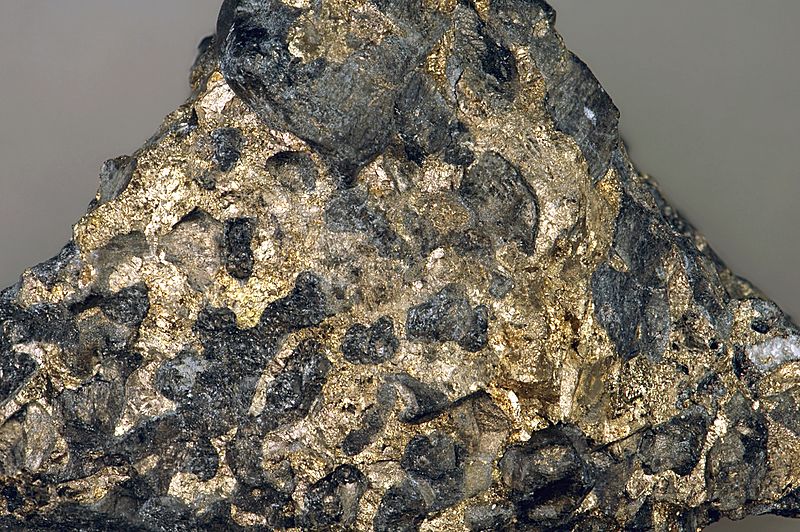Image: Sulfidic serpentintite (platinum-palladium ore) Johns-Manville Reef, Stillwater Complex

Description: Sulfidic serpentinite (field of view ~9.5 cm across) from the Johns-Manville Reef, Lower Banded Series, Stillwater Complex (Neoarchean, 2.71 b.y.) in the Stillwater Mine, Beartooth Mountains, Montana, USA. Black: serpentine mixed with a little magnetite (formerly dunite). Metallic-lustered areas: Pt/Pd-rich chalcopyrite & pyrrhotite. This is an altered pegmatitic dunite very richly infused with intercumulate Pt/Pd-rich chalcopyrite & pyrrhotite. Dunites are >90% olivine peridotites (ultramafic, intrusive igneous rocks). During metamorphism, olivine typically converts to serpentine, if water is present. The resulting rock is serpentinite. In this sample, the blackish areas are serpentine masses (formerly large olivine crystals). Some magnetite is also mixed in with the serpentine. This ore sample grades to about 2.5 ounces of Pd-Pt per ton of rock, with a Pd-Pt ratio of about 3:1 (= highest grade platinum group metals deposit in the world). Locality: 55W15100 D1 area (5500’ elevation above sea level & 15,100’ west of shaft), Stillwater Mine, underground & west of the Stillwater River, southwestern Stillwater County, Beartooth Moutains, southern Montana, USA. Southern Montana’s Beartooth Mountains has one of only three platinum mines in North America. There, platinum and palladium are mined from the 2.71 billion-year-old Stillwater Complex, a classic example of an LLI (large, layered igneous province). LLIs are large intrusive bodies that display large-scale and small-scale layering, even including cross bedding, ripples, graded bedding, channelforms, and other sedimentary-like features. The Stillwater started out as a large subsurface mass of slowly cooling magma. As various minerals crystallized, they settled to the bottom of the magma chamber. This resulted in layering. Igneous rocks that formed this way have a cumulate texture. Currents in the still-liquid portions of the magma chamber produced the sedimentary structures mentioned above. Most of the Stillwater displays only large-scale layering. The rocks in the Stillwater are ultramafic & mafic intrusive igneous rocks. Common lithologies include gabbros, norites, harzburgites, anorthosites, troctolites, chromitites, pyroxenites, and dunites. Portions of the Stillwater have been metamorphosed. Olivine is the most commonly altered component, usually metamorphosed to serpentine. The main platinum & palladium occurrence is in the Johns-Manville Reef (J-M Reef), an interval in the lower part of the Lower Banded Series. There, the Pt & Pd occur in intercumulate sulfides, typically pyrrhotite (Fe1-xS) and chalcopyrite (CuFeS2). Platinum ores in the J-M Reef are principally sulfidic anorthosites, but other lithologies also occur. The J-M Reef is the highest grade deposit known for platinum-group elements (PGEs).
Title: Sulfidic serpentintite (platinum-palladium ore) Johns-Manville Reef, Stillwater Complex
Credit: Sulfidic serpentintite (platinum-palladium ore) (Johns-Manville Reef, Lower Banded Series, Stillwater Complex, Neoarchean, 2.71 Ga; 55W15100 D1 area, Stillwater Mine, Beartooth Mountains, southern Montana, USA) 1
Author: James St. John
Usage Terms: Creative Commons Attribution 2.0
License: CC BY 2.0
License Link: https://creativecommons.org/licenses/by/2.0
Attribution Required?: Yes
Image usage

